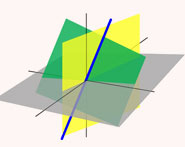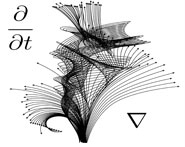


 تاريخ الرياضيات
تاريخ الرياضيات
 الرياضيات في الحضارات المختلفة
الرياضيات في الحضارات المختلفة 
 الرياضيات المتقطعة
الرياضيات المتقطعة
 الجبر
الجبر
 الهندسة
الهندسة 
 المعادلات التفاضلية و التكاملية
المعادلات التفاضلية و التكاملية 
 التحليل
التحليل
 علماء الرياضيات
علماء الرياضيات |
Read More
Date: 1-3-2022
Date: 17-5-2022
Date: 22-7-2016
|
The Errera graph is the 17-node planar graph illustrated above that tangles the Kempe chains in Kempe's algorithm and thus provides an example of how Kempe's supposed proof of the four-color theorem fails.
The Fritsch graph and Soifer graph provide smaller (and in fact the smallest possible) counterexamples.
A number of other embeddings (many of which are vertex-vertex and/or edge-vertex degenerate) are illustrated above.
The Errera graph has no planar unit-distance embedding (since it contains the 9-node triangular cupola unit-distance forbidden graph), but a beautiful three-dimensional unit-distance embedding can be obtained from two oppositely-oriented copies of a gyroelongated pentagonal pyramid, i.e., a truncated regular icosahedron with one vertex and adjoining faces removed, adjoined at their pentagonal faces (E. Weisstein, Mar. 8, 2022).
Errera, A. Du colorage de cartes et de quelques questions d'analysis situs. Ph.D. thesis. Paris: Gauthier-Villars, 1921.
Gethner, E. and Springer, W. M. II. "How False Is Kempe's Proof of the Four-Color Theorem?" Congr. Numer. 164, 159-175, 2003.
Kempe, A. B. "On the Geographical Problem of Four-Colors." Amer. J. Math. 2, 193-200, 1879.
Wagon, S. Mathematica in Action, 2nd ed. New York: Springer-Verlag, pp. 522-524, 1999.



|
|
|
|
دخلت غرفة فنسيت ماذا تريد من داخلها.. خبير يفسر الحالة
|
|
|
|
|
|
|
ثورة طبية.. ابتكار أصغر جهاز لتنظيم ضربات القلب في العالم
|
|
|
|
|
|
|
سماحة السيد الصافي يؤكد ضرورة تعريف المجتمعات بأهمية مبادئ أهل البيت (عليهم السلام) في إيجاد حلول للمشاكل الاجتماعية
|
|
|